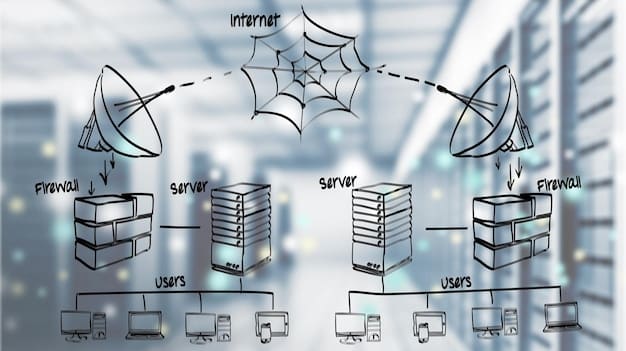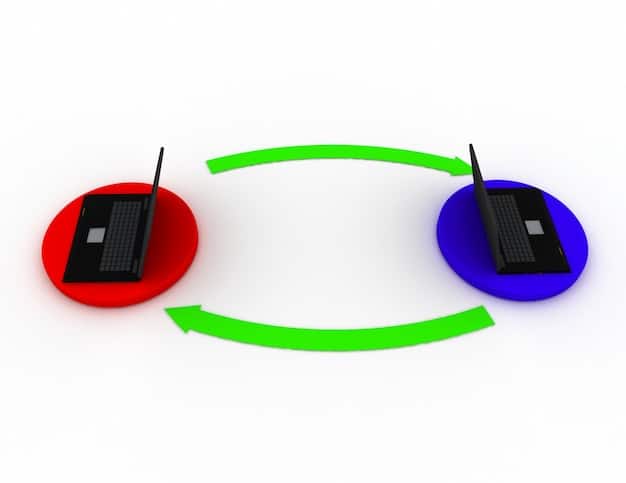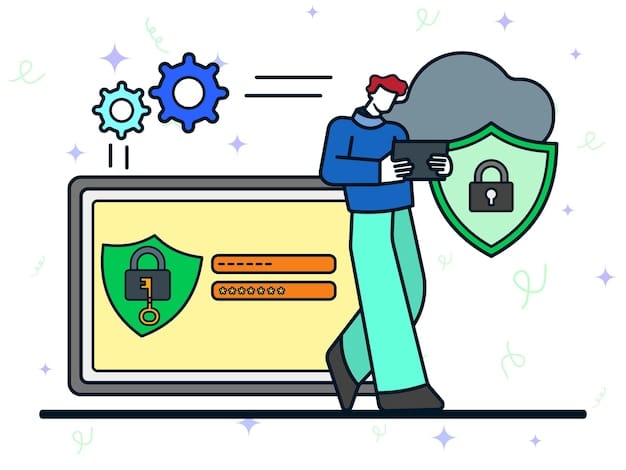WebSockets Tutorial: Real-Time Communication Guide for US Developers

WebSockets provide a persistent connection between a client and a server, enabling real-time data exchange crucial for applications like live chat, online gaming, and collaborative tools; this step-by-step tutorial equips US developers with the knowledge to effectively use WebSockets for building responsive and interactive web applications.
Want to build web apps that feel truly live? This tutorial dives into how to use WebSockets for real-time communication: a step-by-step tutorial for US developers, covering everything from the basics to practical implementation in America.
Understanding WebSockets: The real-time revolution
WebSockets have transformed the way web applications handle real-time data, moving away from traditional request-response models. Let’s delve into what WebSockets are and why they are a game-changer for developers.
What are WebSockets?
Unlike HTTP, which is stateless and operates on a request-response cycle, WebSockets provide a persistent, two-way communication channel over a single TCP connection. This allows for full-duplex communication, where both the client and server can send data simultaneously without the overhead of repeatedly establishing new connections.
Why use WebSockets?
The benefits of using WebSockets are significant, especially for applications requiring real-time updates. They reduce latency, minimize server load, and provide a more seamless user experience compared to techniques like polling or long polling. This makes them ideal for:
- Real-time chat applications
- Online gaming
- Collaborative editing tools
- Live dashboards and notifications

In essence, WebSockets empower developers to create more engaging and responsive web applications, delivering information to users instantly as it becomes available.
Setting Up Your WebSocket Environment
Before diving into code, it’s crucial to set up your development environment. This involves choosing a WebSocket server library, understanding the necessary technologies, and configuring your development tools.
Choosing a server library
Several WebSocket server libraries are available, each with its own strengths and weaknesses. Popular choices include:
- Node.js with Socket.IO: A widely used combination, especially for JavaScript developers, offering a simple and intuitive API.
- Python with Autobahn: A robust and scalable option for Python-based applications, supporting both WebSocket and WAMP (WebSocket Application Messaging Protocol).
- Java with Jetty: A mature and production-ready server that seamlessly integrates with Java web applications.
Essential technologies
To effectively work with WebSockets, you should be familiar with:
- HTML: For building the basic structure of your web application.
- JavaScript: For handling WebSocket communication on the client-side.
- Your chosen server-side language: (e.g., Node.js, Python, Java) for implementing the WebSocket server.
Setting up your environment correctly ensures a smooth development process and avoids common pitfalls associated with WebSocket implementation. This also includes ensuring your development tools (like IDEs and text editors) are properly configured for your chosen language and technologies.
Client-Side WebSocket Implementation
The client-side implementation involves establishing a WebSocket connection from your web browser and handling incoming and outgoing messages. Let’s explore this in detail.
Establishing a connection
In JavaScript, creating a WebSocket connection is straightforward:
const socket = new WebSocket('ws://your-websocket-server.com');
Replace 'ws://your-websocket-server.com' with the actual URL of your WebSocket server. Note the ws:// protocol, which indicates a non-secure WebSocket connection. For secure connections, use the wss:// protocol.
Handling messages
Once the connection is established, you can handle incoming and outgoing messages using event listeners:
socket.addEventListener('open', (event) => {
console.log('Connected to WebSocket server');
socket.send('Hello from the client!');
});
socket.addEventListener('message', (event) => {
console.log('Message from server:', event.data);
});
socket.addEventListener('close', (event) => {
console.log('Disconnected from WebSocket server');
});
socket.addEventListener('error', (event) => {
console.error('WebSocket error:', event);
});
These event listeners allow you to react to different stages of the WebSocket lifecycle, such as connection establishment, message reception, disconnection, and error events. Proper client-side implementation is critical for a responsive and reliable real-time application.
Server-Side WebSocket Implementation (Node.js Example)
Implementing the server-side component involves setting up a WebSocket server that can handle incoming connections and messages. This section demonstrates a basic implementation using Node.js and Socket.IO to build an example for US developers.
Setting up the server
First, install the necessary packages:
npm install socket.io
Then, create a basic server:
const io = require('socket.io')(3000, {
cors: {
origin: "*",
methods: ["GET", "POST"]
}
});
io.on('connection', socket => {
console.log('User connected');
socket.on('disconnect', () => {
console.log('User disconnected');
});
socket.on('message', message => {
console.log('Message received: ' + message);
io.emit('message', message); // Broadcast the message to all clients
});
});
Handling connections
The io.on('connection', ...) block handles incoming WebSocket connections. Inside this block, you can listen for specific events, such as:
- connect: Emitted when a new client connects to the server.
- message: Emitted when the server receives a new text message from a client.
- disconnect: Emitted when a client disconnects from the server.
Broadcasting messages
To send messages to all connected clients, you can use the io.emit() method. For example:
io.emit('message', 'Hello from the server!');
This would send the message “Hello from the server!” to all clients connected to the WebSocket server. The proper and careful implementation of server-side logic is crucial for managing connections, processing messages, and maintaining the overall functionality of your real-time application. Consider security implications and scaling requirements as well.
Securing Your WebSockets
Security is paramount when implementing WebSockets, especially when dealing with sensitive data. Several measures can be taken to protect your WebSocket communication.
Using WSS
Just like HTTPS provides a secure connection for HTTP traffic, WSS (WebSocket Secure) provides encryption for WebSocket communication. To use WSS, you need to:
- Obtain an SSL/TLS certificate for your domain.
- Configure your WebSocket server to use the certificate.
- Use the
wss://protocol in your client-side code.
Authentication and Authorization
To ensure that only authorized users can access your WebSocket server, you should implement authentication and authorization mechanisms. Common approaches include:
- Token-based authentication: Use JWTs (JSON Web Tokens) to authenticate users and authorize access to specific WebSocket endpoints.
- Session-based authentication: Use server-side sessions to track authenticated users and control access to WebSocket resources.

Implementing robust security measures is essential for protecting your WebSocket communication from eavesdropping, tampering, and unauthorized access. This ensures the privacy and integrity of your data, as well as the overall security of your application. Consider implementing rate limiting and input validation to prevent abuse.
Testing and Troubleshooting WebSockets
Thorough testing and effective troubleshooting are essential for ensuring the reliability and stability of your WebSocket implementations. Here’s a guide to help you through the process.
Testing tools
Several tools can assist you in testing your WebSockets:
- WebSocket client extensions for browsers: Extensions like Simple WebSocket Client for Chrome allow you to manually connect to a WebSocket server and send/receive messages.
- Postman: A popular API testing tool that also supports WebSocket connections.
- Online WebSocket testing services: Services like WebSocket.org offer simple interfaces for testing WebSocket connections.
Common issues and solutions
Here are some common issues you might encounter when working with WebSockets, along with potential solutions:
- Connection refused: Ensure your WebSocket server is running and accessible from your client. Check firewall settings and network configurations.
- Unexpected disconnections: Investigate server-side logs for errors or resource limitations. Implement heartbeat mechanisms (sending periodic messages) to keep the connection alive.
- Message loss or corruption: Ensure proper message formatting and encoding (e.g., UTF-8). Implement error handling and retry mechanisms.
Regular testing and proactive troubleshooting are vital for identifying and resolving issues early on, ensuring a smooth and reliable real-time experience for your users. Monitoring server performance and network conditions can also help pinpoint potential problems.
| Key Point | Brief Description |
|---|---|
| 🚀 Real-Time Communication | WebSockets enable bidirectional data flow, crucial for live updates. |
| 🛠️ Server Setup | Choose a WebSocket library like Socket.IO (Node.js) or Autobahn (Python). |
| 🔒 Security Measures | Use WSS for encryption and implement authentication/authorization. |
| 🧪 Testing and Debugging | Use tools like browser extensions and Postman for testing and debugging. |
Frequently Asked Questions
WebSockets offer full-duplex communication, reducing latency and server load, unlike HTTP polling which requires constant requests. This makes WebSockets ideal for real-time applications.
Secure WebSockets by using the WSS protocol, implementing authentication, and adding authorization. Always encrypt your WebSockets and check the SSL/TLS certificate.
Yes, WebSockets are compatible with nearly any language. Libraries are available for Node.js, Python, Java, and many other languages to facilitate their use.
Socket.IO is a library that enables real-time, bidirectional communication between web clients and servers and is often used with WebSockets. Can also handle fallback where needed with older technologies.
Check server logs, monitor network conditions, and implement a heartbeat mechanism to prevent disconnections. Ensure that you properly handle reconnections as part of your logic.
Conclusion
By understanding the core concepts, implementing secure connections, and following best practices, US developers can effectively leverage how to use WebSockets for real-time communication: a step-by-step tutorial for US developers, building innovative and engaging real-time applications that meet the demands of today’s users.





